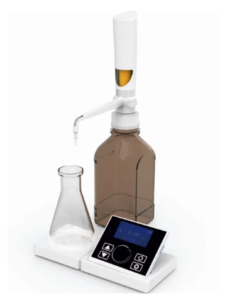A burette is a laboratory apparatus used in quantitative chemical analysis to measure the volume of a liquid or a gas. It consists of a graduated glass tube with a stopcock (turning plug, or spigot) at one end.
Key features of a burette:
- Graduated glass tube: The tube is marked with precise measurements, typically in milliliters (mL).
- Stopcock: A valve that controls the flow of liquid from the burette.
- Tip: A narrow outlet for precise delivery of the liquid.
How a burette is used:
- Filling: The burette is filled with the desired liquid, ensuring there are no air bubbles trapped inside.
- Titration: In a titration, a known volume of a solution is added from the burette to another solution until a specific endpoint is reached.
- Volume Measurement: The initial and final readings on the burette are recorded to determine the volume of liquid dispensed.
Importance of burettes in chemistry:
- Accurate measurements: Burettes allow for precise volume measurements, which are essential in many chemical analyses.
- Titrations: They are widely used in titrations, a technique to determine the concentration of a solution.
- Quantitative analysis: Burettes help in quantitative analysis by measuring volumes of reactants and products.
In summary, a burette is a valuable tool in a chemist’s laboratory, ensuring accurate and precise measurements for various experiments and analyses.
Burette

